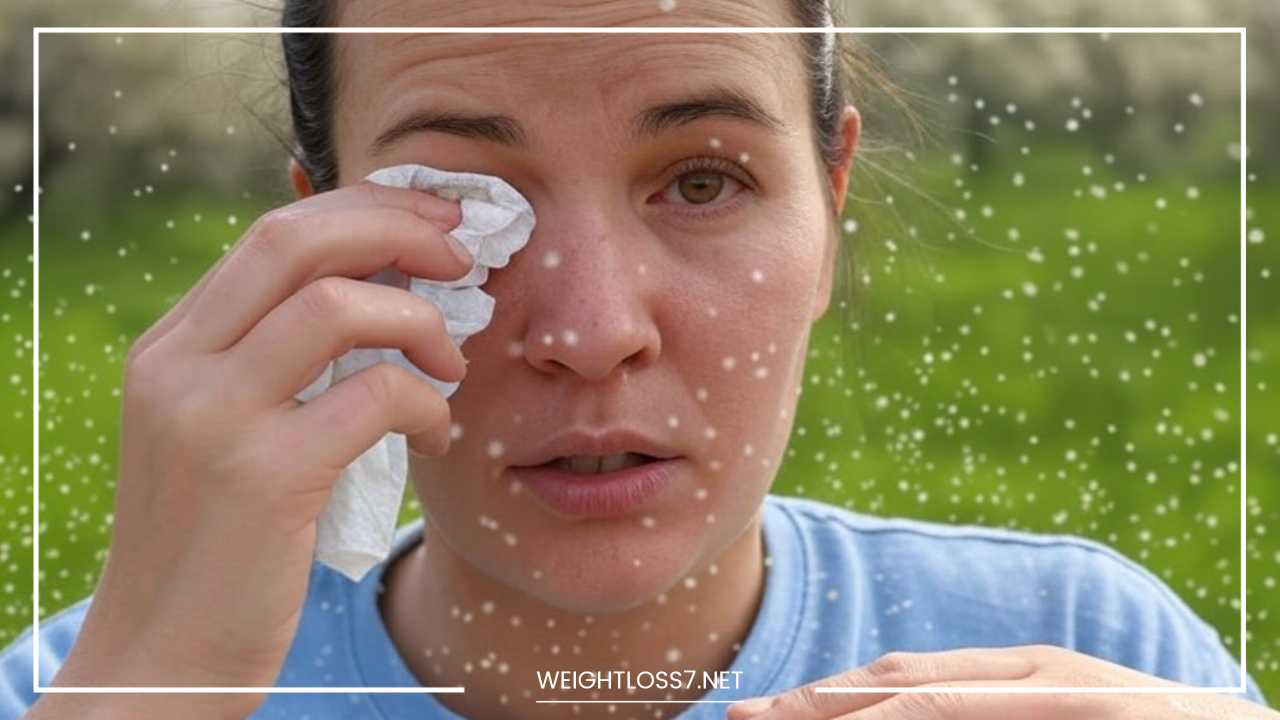How to Stop Hay Fever Immediately

Stop Hay Fever Immediately
Conquer Hay Fever: A Comprehensive Guide to Immediate and Long-Term Relief
Hay fever, scientifically known as allergic rhinitis, is one of the most common chronic conditions affecting people worldwide.
It’s a condition in which the immune system reacts to airborne allergens, such as pollen, pet dander, mold, and dust mites, resulting in an uncomfortable array of symptoms that include sneezing, nasal congestion, itchy eyes, and a runny nose.
For millions, hay fever isn’t just a seasonal annoyance; it significantly impacts daily life, including work, school, and social activities.
While there is no known cure for hay fever, a well-rounded, comprehensive approach involving both immediate relief and long-term management can make a world of difference in managing symptoms and enhancing quality of life.
Understanding Hay Fever: The Immune System’s Overreaction
Hay fever occurs when the immune system mistakenly identifies harmless substances—such as pollen or dust mites—as harmful invaders.
This misidentification triggers the body’s defense mechanisms, resulting in the release of histamine, a key chemical responsible for allergic reactions.
Histamine acts on various parts of the body, leading to inflammation and irritation, which manifests as the hallmark symptoms of hay fever.
The most common triggers for hay fever include:
- Pollen: Released by trees, grasses, and weeds during specific seasons.
- Dust Mites: Tiny insects that thrive in warm, humid environments, often found in bedding and upholstery.
- Pet Dander: Skin flakes and saliva from furry pets like cats and dogs.
- Mold Spores: Fungi found in damp environments, including basements and bathrooms.
- Cockroach Allergens: Particles from cockroaches or their droppings can also provoke allergic reactions.
When allergens enter the body, the immune system releases histamine and other chemicals to combat what it perceives as a threat.
This causes the swelling of the nasal passages, increased mucus production, and irritation of the eyes and throat. The result? The common symptoms of hay fever—sneezing, a stuffy nose, itchy or watery eyes, and coughing—are all triggered.
Understanding these mechanisms is the first step in tackling hay fever effectively. By addressing both the immune response and external triggers, it’s possible to reduce the frequency and severity of allergic reactions.
Immediate Relief: Strategies for Quick Symptom Control
While long-term management is vital for minimizing hay fever symptoms over time, when symptoms flare up, quick relief is often necessary. Here’s a detailed look at several strategies that can provide immediate comfort:
1. Allergen Avoidance: The Most Effective Defense
The best way to prevent hay fever symptoms from worsening is to limit exposure to allergens. While this might seem difficult, taking proactive steps can make a significant impact:
- Pollen Monitoring: During peak pollen seasons, pollen counts can reach high levels, especially on dry, windy days. You can track these levels through weather apps or websites and adjust your activities accordingly. On days when the pollen count is high, try to stay indoors as much as possible. If you must go outside, try to do so in the early morning or late evening, as pollen levels are generally lower during these times.
- Indoor Air Quality: Keep windows and doors closed, especially during periods of high pollen count. Using HEPA (High-Efficiency Particulate Air) filters in air purifiers can help trap airborne allergens and improve indoor air quality. You can also install HEPA filters in your vacuum cleaner to prevent allergens from spreading while cleaning your home.
- Cleaning Habits: Regularly clean your living space, especially in areas where dust, pet dander, or mold spores accumulate. Dust and vacuum frequently, and use damp cloths rather than dry ones to avoid spreading dust particles. If possible, try to use a vacuum cleaner with a HEPA filter.
- Bedroom Sanctuary: Creating an allergen-free space in your bedroom is critical, as this is where you spend many hours each day. Wash bedding frequently in hot water to remove any dust mites and other allergens. Use allergen-proof mattress and pillow covers to reduce exposure to dust mites.
- Personal Hygiene: After spending time outdoors, take a shower to rinse away any pollen or allergens that may have settled on your skin and hair. Change into clean clothes to avoid bringing allergens into your home.
2. Nasal Irrigation: Flushing Out Allergens
Nasal irrigation is an effective technique that can provide immediate relief from nasal congestion. This method involves rinsing the nasal passages with a saline solution to remove trapped allergens, mucus, and other irritants.
Nasal irrigation can be done using a neti pot or a squeeze bottle. This practice helps reduce inflammation in the nasal passages and clears out allergens that are causing irritation.
When performing nasal irrigation, always use sterile or distilled water to avoid introducing bacteria or pathogens into your nasal passages.
You can purchase pre-made saline solutions at your local pharmacy or make your own by dissolving salt in warm, distilled water.
3. Over-the-Counter Medications: A Convenient Solution
Many over-the-counter (OTC) medications are available that can quickly alleviate hay fever symptoms.
These medications are widely accessible and can be effective in providing temporary relief from the most common symptoms.
- Antihistamines: These are the most common medication for treating hay fever symptoms. Antihistamines block the effects of histamine, which helps reduce sneezing, itching, and watery eyes. There are many types available, including non-drowsy formulations, so you can find one that works best for your needs. Some common antihistamines include loratadine (Claritin), cetirizine (Zyrtec), and fexofenadine (Allegra).
- Decongestants: Decongestants are helpful for relieving nasal congestion by reducing swelling in the nasal passages. Oral decongestants, such as pseudoephedrine (Sudafed), are available over-the-counter, as are nasal sprays like oxymetazoline (Afrin). While nasal decongestants can provide quick relief, they should be used sparingly, as prolonged use can lead to a condition called rebound congestion, where symptoms worsen after discontinuation.
- Nasal Corticosteroids: These sprays reduce inflammation in the nasal passages and provide relief from symptoms such as congestion, sneezing, and a runny nose. They are particularly effective when used regularly, even before symptoms become severe. Popular nasal corticosteroids include fluticasone (Flonase) and triamcinolone (Nasacort).
4. Eye Drops: Targeting Itchy, Watery Eyes
If your hay fever symptoms involve itchy, red, or watery eyes, eye drops can offer immediate relief.
Antihistamine eye drops, such as ketotifen (Zaditor), can quickly reduce itching and inflammation.
Lubricating eye drops are also helpful in moisturizing the eyes, preventing dryness and discomfort.
Cool compresses can also provide soothing relief for irritated eyes. Simply soak a clean cloth in cool water and apply it to the eyes for a few minutes to alleviate itching and swelling.
5. Lifestyle Adjustments: Small Tweaks, Big Impact
In addition to medications, certain lifestyle changes can make a significant difference in how you manage hay fever symptoms:
- Hydrate Well: Drinking plenty of water can help thin mucus, making it easier to drain from the nasal passages and sinuses. This can help alleviate congestion and reduce the overall intensity of symptoms.
- Use a Humidifier: Especially during the winter months when indoor air tends to be dry, using a humidifier can help keep your nasal passages moist and prevent irritation caused by dryness. It’s important to clean your humidifier regularly to prevent mold and bacteria buildup.
- Wear Sunglasses: Wearing sunglasses when outdoors can protect your eyes from pollen and other airborne irritants, which can help reduce itching and redness.
Long-Term Relief: Developing a Robust Defense System
While immediate relief strategies help you manage symptoms in the short term, it’s essential to take a long-term approach to prevent hay fever from becoming a recurring issue. Here are several key strategies for managing hay fever over the long haul:
1. Allergy Immunotherapy: The Long-Term Solution
For individuals with severe or persistent hay fever, allergy immunotherapy (also known as allergy shots or sublingual tablets) can provide long-lasting relief.
This treatment involves gradually introducing the allergen into the body in controlled amounts, allowing the immune system to build up tolerance over time.
Immunotherapy typically requires several months of treatment but can offer permanent or long-lasting relief once the immune system is desensitized.
Allergy shots are administered by a healthcare provider in a series of injections, while sublingual tablets are taken orally under the tongue. Over time, the body’s reaction to the allergens lessens, significantly reducing symptoms.
2. Prescription Medications: For More Severe Symptoms
If over-the-counter medications aren’t enough to control your symptoms, your healthcare provider may recommend stronger prescription medications. These can include:
- Stronger Antihistamines: Prescription-strength antihistamines may be more effective for individuals who don’t find relief with OTC options.
- Nasal Corticosteroids: Prescription nasal sprays tend to be stronger than over-the-counter options and may offer better long-term relief.
- Leukotriene Modifiers: These medications, such as montelukast (Singulair), block the chemicals responsible for inflammation and allergic reactions, providing relief from hay fever symptoms.
3. Alternative Therapies: Exploring Complementary Approaches
While scientific evidence supporting the effectiveness of alternative therapies for hay fever is still limited, some people find relief through methods such as acupuncture, acupressure, or herbal remedies.
Certain herbal supplements, such as butterbur or quercetin, may have anti-inflammatory and antihistamine effects.
However, it’s essential to consult with a healthcare provider before trying any alternative treatments, especially if you are already taking other medications.
Holistic Hay Fever Management: A Comprehensive Approach
Effectively managing hay fever requires more than just medications; a holistic approach that includes lifestyle changes, regular symptom tracking, and mental well-being strategies can significantly improve your overall quality of life:
- Keep a Symptom Diary: Keeping a detailed record of your symptoms and their triggers can help you pinpoint patterns, identify potential allergens, and better tailor your treatment plan.
- Stress Management: Stress can worsen allergic reactions, so incorporating stress-reducing practices such as yoga, meditation, or deep breathing exercises can have a positive impact on symptom management.
- Maintain a Healthy Diet: A balanced diet rich in fruits, vegetables, and antioxidants can support a healthy immune system, potentially reducing the severity of allergic reactions.
When to Seek Professional Help: Recognizing the Red Flags
While most cases of hay fever can be managed with OTC medications and lifestyle changes, it’s essential to seek professional help if:
- Your symptoms are severe, persistent, or significantly impact your daily activities.
- OTC medications are no longer providing relief.
- You experience frequent sinus infections or ear infections.
- You have difficulty breathing or wheezing, which could signal the onset of asthma or other respiratory issues.
A healthcare provider can help diagnose your condition, perform allergy tests, and develop a personalized treatment plan. They can also rule out other potential causes of your symptoms, such as a cold or sinus infection.
Living Well with Hay Fever: A Proactive Approach
While hay fever can be a frustrating and persistent condition, it doesn’t have to control your life.
By understanding the underlying mechanisms, employing immediate relief strategies, and adopting long-term management techniques, you can keep your symptoms under control and regain your quality of life.
A proactive, comprehensive approach that involves lifestyle changes, medication, and consistent care will allow you to live more comfortably with hay fever, enjoy the outdoors, and minimize its impact on your day-to-day activities.

















